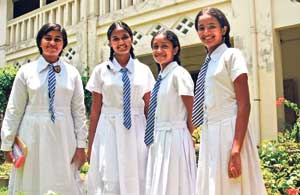
| Children help to protect Sri Lanka’s future "We do not inherit the earth, we borrow it from our children.” It is often said that children are the future. What is even more true is that trees are the future. When we are all dead and gone, trees will still be standing proud watching over our children and even our children's children. But that has not stopped adults from cutting down the forests of Sri Lanka for centuries leaving just desert, where once there was exotic wildlife. At the beginning of the last century most of Sri Lanka was covered in forest, now it is less than a quarter.
In an age of climate change and environmental destruction it is up to children to protect forests. Trees not only absorb carbon emissions, the pollutants that are causing global warming, but sustain delicate eco-systems under threat as the world heats up. Just by being aware you can help preserve the forests that are home to thousands of species of threatened creatures. Ruk Rakaganno, The Tree Society of Sri Lanka, has been educating children across Sri Lanka about the importance of trees. Affectionately known as Ruk Raks, the organisation is keen to educate children about the importance of trees so that they can protect their country's beauty and biodiversity for the future. Ruk Raks started their current schools awareness programme in 2005, in areas affected by the tsunami. So far thousands of children have taken part. Young zoologists arrive at the school with power point presentations on the importance of trees to tackle coastline erosion, short films on environmental degradation and a great passion for the wildlife of Sri Lanka. All children welcome the opportunity to bunk classes but this is even better. To gasps and giggles they are shown how to avoid some of Sri Lanka's many poisonous snakes, shocking pictures of illegal turtle hunting and images of some of Sri Lanka's spectacular wildlife under threat. The more serious message underneath is to educate children about their natural heritage. Sri Lanka is one of the biodiversity "hotspots" of the world. However with increasing population pressure and climate change, 84 per cent of flora and 45 per cent of fauna is under threat. For example, Sri Lanka has the largest variety of amphibians in the world with more than 250 species, many living in endangered rainforests.
The short presentation lasts around two hours and at a later date Ruk Raks will return and plant trees in order to continue the learning process and encourage further commitment to the environment. Schools can even arrange competitions to see who can best look after a tree. Biodiversity is part of the curriculum so the lecture can also help students to learn for their exams. Sonali Muthukumarana, 17, a student at Convent of Mary Immaculate in Matara, who took part in a recent Ruk Raks session, said it was far more fun than an ordinary biology session. But much more than that she was learning about how important it is to protect her country's natural resources. "We are the future generation. We are the young blood. So if we learn about biodiversity we will be able to protect the precious earth," she said. Gihan Madhushanka, 16, a pupil at Meegasdeniya School near Tangalle was inspired by the programme to protect the plants and animals around him. "We have some endangered animals in Sri Lanka. By watching this we know not to kill or harm those species." Even though the students are young, they often feel even more passionately about the environment because it is they who will suffer if the plants and trees are not protected. As Gihan said: "We get our oxygen from trees and that is the most important thing in our life. We also get food, shade and medicine from trees. If there are no trees then there is no future." How much do you know about your own environment? Q1. What percentage of Sri Lanka's plant life is under threat? Some 84 per cent of flora and 45 per cent of fauna is under threat in Sri Lanka. Q2. What kind of animal is found in highest density in Sri Lanka? Sri Lanka has more amphibians per square mile than any other country in the world, with more than 250 species. Q3. How much of Sri Lanka is covered in forest compared to the beginning of the last century? At the beginning of the last century most of Sri Lanka was covered in forest but it is now less than a quarter. Would you like Ruk Raks to come to your school? Write to us at: Ruk Rakaganno Website : |
|| Front
Page | News | Editorial | Columns | Sports | Plus | Financial
Times | International | Mirror | TV
Times | Funday
Times || |
| |
Reproduction of articles permitted when used without any alterations to contents and a link to the source page.
|
© Copyright
2008 | Wijeya
Newspapers Ltd.Colombo. Sri Lanka. All Rights Reserved. |

